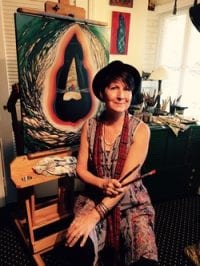
The Shadow Behind the Light
Pain, Healing and the Art of D YaeL Kelley
by DAVID MORRIS
The role of art in healing is as diverse and enduring as its role in life itself. Some of the earliest human sculptures are thought to have been used in rituals that connected humans to their environment. In the present day, we watch movies and read books to navigate the pains and challenges of our complex lives.
But sometimes art plays a more direct and literal role in healing – just ask D YaeL Kelley. When she was just 17, the St. Petersburg-based painter was struck by a negligent driver while at a stop light. Her injuries were severe, and she was bedridden for months.
But it wasn’t until years later, after mounting headaches, that someone noticed the worst of the injuries – she’d suffered a hairline fracture in her C1 vertebrae. Located in the neck, the C1 is often the site of the worst spinal cord injuries. YaeL was lucky not to be paralyzed – she and her doctors credit her devotion to tournament fencing, dancing, and later, barefoot running for that. But as time passed, the fracture caused mounting, unremitting headaches.

D YaeL Kelley | Lights Beyond – Conversations with the Mockingbird #1 | Oil | 30 x 40 inches
“They told me, ‘It’s never going to stop hurting,’” she recounted from her St. Pete studio, where she paints for hours nearly every day. “This injury isn’t something you’re going to recover from.”
The doctors were right. For the nearly four decades since, Kelley has fought to manage near-constant pain. A surgery in 2002 made it slightly more manageable. But she still sleeps on ice packs every night, waking every two or three hours to change them.
“I had a headache for 26 years,” she laughs with wry understatement.
Dealt a devastating hand at the beginning of her life, Kelley turned to an already-familiar comfort. She had started painting at age 14, and had always been fascinated by the work of Frida Kahlo. But only after her injury did Kelley learn more about Kahlo as a person – and the parallels between their lives became a touchstone.
“I was in my accident when I was 17,” Kelley says. “Kahlo was involved in a bad trolley accident when she was 17. It prevented her from having children, and the pain became more and more severe. She spent months in plaster braces, and started painting when she was recuperating.”
“Her life was really her pain, and how she dealt with it was catalogued in her painting.”
Kelley, too, painted through and, indirectly, about her pain. She describes her time in the studio as a kind of trance state, spent working for eight to ten hours at a stretch. Her injury keeps her from sitting, so her workflow involves constant motion. She rotates between six or more canvasses in progress at one time, each made up of dozens of layers of pigment suspended in glaze.
These are also the only times, she says, when she feels truly free of pain.

D YaeL Kelley | Stillmore 2 | Oil and gold leaf | 16 x 12 inches
“I can paint for hours and hours, and I have no pain, because I’m focused completely on the work.”
On the surface much of her work is very approachable – and surprisingly, that, too, comes from her pain.
“I’m looking for the still point. I’m looking for the quiet and serene. Pain makes you seek the beauty.”
Still, even in the serene images she lays down, you can see what she calls the “shadow behind the light” – the inkling of her constant companion.
Art has become more and more recognized as a tool for dealing with just the sort of chronic problems that Kelley faces. Organizations like the America Academy for Art Therapy work to spread the word about the impact painting and other arts can have for people struggling with PTSD, addiction, mental illness, and anxiety. What YaeL experiences in the flow state of a professional artist is being spread around the country and the world to others in need.
“It’s focus,” Kelley says, that gives the practice of art such near-miraculous powers to calm and center even the stormiest of minds. “It’s being able to take yourself completely out of your surroundings, and focus completely on what you’re doing.”
“Art has always had the ability to release me from that pain, to take me to someplace visceral, someplace beautiful.”



